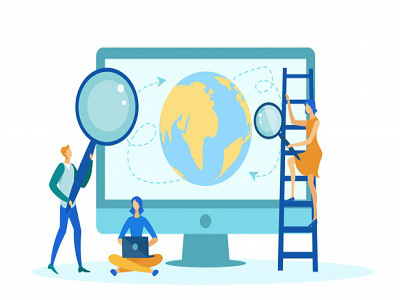In today’s digital age, the internet has become an indispensable tool in the field of education. The phrase “How the internet helps in education” resonates with the transformative power that this vast virtual realm wields in shaping the way we learn and acquire knowledge. From providing access to a wealth of information to facilitating interactive learning experiences, the internet has revolutionized the educational landscape.
The Internet as a Gateway to Knowledge
The internet serves as a gateway to a treasure trove of knowledge. With just a few clicks, students and educators alike can access a vast repository of information on a wide range of subjects. This accessibility has broken down the barriers to learning, allowing individuals from all walks of life to pursue their educational aspirations.
Internal Link: Book Review – Rationality by Steven Pinker
One notable example of how the internet aids in education is the availability of digital libraries and online resources. Gone are the days when students had to rely solely on physical books and limited references. Today, they can access digital libraries and e-books, making research and studying more convenient and efficient.
Interactive Learning Through Online Courses
Another aspect of how the internet helps in education is the proliferation of online courses. The internet has democratized education by offering a plethora of courses on various subjects, often at little to no cost. These courses come in diverse formats, from video lectures to interactive quizzes, catering to different learning styles.
Internal Link: Literature and Real Life
Online courses have made it possible for learners to explore new areas of interest or enhance their existing skills without the constraints of traditional classrooms. This flexibility is a testament to how the internet has empowered individuals to take control of their education.
The Role of Social Media in Learning
In the modern era, social media platforms have become an integral part of our daily lives. Surprisingly, they also play a significant role in education. Platforms like Facebook, Twitter, and LinkedIn offer opportunities for students and educators to connect and collaborate.
Through online communities and groups, learners can discuss academic topics, share resources, and seek advice from peers and experts. This collaborative approach to learning is a testament to how the internet fosters a sense of camaraderie among those pursuing knowledge.
Contradictions in Online Education
While the internet undeniably provides numerous benefits in education, it’s essential to acknowledge the contradictions that exist. The same tool that offers a wealth of information can also be a source of distraction. Students may find themselves easily sidetracked by social media or unrelated websites when they should be studying.
However, these contradictions are not unique to online education. In traditional classrooms, students can also face distractions. The key lies in developing self-discipline and effective time management skills, which are valuable life lessons in themselves.
Idioms of Internet Learning
Just as every cloud has a silver lining, so does online education. It’s a double-edged sword, but with the right approach, one can reap the benefits while minimizing the drawbacks. Learning through the internet is like riding a rollercoaster; it has its ups and downs, but the thrill of acquiring knowledge makes it all worthwhile.
Translational Phrases in the Digital Learning Era
As we transition into a digital learning era, the internet’s impact on education becomes more evident than ever. The phrase “How the internet helps in education” is no longer a mere statement; it’s a testament to the ongoing transformation of the educational landscape. From access to knowledge to interactive learning opportunities, the internet has redefined the way we acquire and apply knowledge.

Navigating the Digital Learning Landscape
In our quest to understand “How the internet helps in education,” let’s delve deeper into the multifaceted ways in which this digital marvel enhances the learning experience.
Personalized Learning
One of the most remarkable aspects of the internet’s impact on education is its ability to offer personalized learning experiences. Educational websites and platforms employ algorithms to analyze a student’s strengths and weaknesses, tailoring the content to their individual needs. This approach ensures that learners receive the most relevant and effective materials, optimizing their learning journey.
Imagine a student, let’s call her Sarah, who is struggling with algebra. Thanks to the internet, she can access specialized algebra tutorials and practice problems that cater to her specific areas of difficulty. This personalized assistance not only boosts her understanding of the subject but also enhances her confidence and motivation.
Expanding Horizons Through Virtual Tours
The phrase “How the internet helps in education” extends beyond textbooks and lectures. The internet offers immersive experiences that can transport students to far-flung places and historical eras. Virtual tours and 360-degree videos enable learners to explore museums, historical sites, and ecosystems from the comfort of their homes or classrooms.
For instance, a history class studying ancient Egypt can embark on a virtual tour of the pyramids and the Valley of the Kings. As they navigate through these iconic landmarks, they can witness the grandeur of a civilization that existed millennia ago. This hands-on approach to learning not only makes the subject matter more engaging but also leaves a lasting impact on students’ memories.
Bridging the Gap with Online Tutoring
In the realm of education, the internet serves as a bridge that connects students with qualified tutors and educators worldwide. Online tutoring platforms enable learners to receive one-on-one guidance and support in various subjects and skill areas. Whether it’s mastering a foreign language, honing math skills, or preparing for standardized tests, there is an online tutor for virtually every educational need.
Imagine a student, Alex, who is passionate about learning to code but struggles to grasp complex programming concepts. Through an online tutoring platform, Alex can connect with an experienced coding tutor who provides personalized lessons and helps him overcome challenges. This direct mentorship not only accelerates Alex’s learning but also fosters a sense of camaraderie with his tutor.
The Flip Side: Information Overload
While the internet offers a plethora of information, it’s essential to address the potential pitfalls. The phrase “How the internet helps in education” is not without its contradictions. With the abundance of information available, students can sometimes become overwhelmed. The challenge lies in discerning credible sources from unreliable ones and sifting through the vast sea of data.
To navigate this digital minefield, educators must teach students critical thinking skills and information literacy. They need to learn how to evaluate sources, fact-check information, and discern between bias and objectivity. In doing so, students can harness the internet’s resources effectively while avoiding the pitfalls of misinformation.
Idioms of Internet Learning: Riding the Wave
Learning through the internet is akin to riding a wave. It can be exhilarating, with new opportunities and discoveries at every turn. Yet, just like a surfer must navigate the swell and avoid wiping out, students must learn to navigate the digital currents and avoid distractions.
Translational Phrases: The Internet’s Evolution
As we consider “How the internet helps in education,” it’s evident that its evolution is ongoing. The internet continues to shape the educational landscape, pushing boundaries and expanding horizons. From personalized learning to virtual experiences and online tutoring, it offers a wealth of opportunities for learners of all ages.

As we journey further into the digital age, it’s essential to explore the ever-expanding frontiers of internet education. “How the internet helps in education” is a question that continues to evolve, and there are several exciting developments on the horizon.
The Rise of Online Collaborative Projects
The internet’s connectivity has given rise to collaborative projects that transcend geographical boundaries. Students from different corners of the world can now work together on research projects, share ideas, and co-create content. This collaborative approach fosters a sense of global citizenship and exposes learners to diverse perspectives.
Imagine a science project where students from the United States, India, and Brazil collaborate on researching climate change. Through video conferences, shared documents, and online forums, they exchange ideas and pool their knowledge. This collaborative effort not only enhances their understanding of the subject but also promotes cultural exchange and teamwork.
Gamification of Learning
The internet has also witnessed the gamification of education, where elements of gaming are incorporated into the learning process. Educational games and simulations engage students in interactive and immersive experiences, making learning enjoyable and effective.
For instance, a history class studying World War II can play an online simulation game that allows them to strategize as military leaders during the war. This hands-on experience helps students grasp the complexities of history in a way that traditional textbooks cannot.
Embracing the Power of Artificial Intelligence
Artificial intelligence (AI) is another frontier that holds immense potential in internet education. AI-powered chatbots and virtual assistants can provide instant help to students, answering questions and offering guidance 24/7. These AI tools can personalize learning experiences by adapting content and difficulty levels based on individual progress.
Consider a scenario where a student, John, is studying physics and encounters a challenging concept. He can access an AI-powered tutor that provides real-time explanations and practice problems tailored to his needs. This personalized assistance accelerates his understanding and boosts his confidence.
Tackling Internet Inequality
Despite the internet’s numerous advantages in education, it’s crucial to acknowledge the issue of internet inequality. Not all students have equal access to high-speed internet and digital devices, creating a digital divide that hinders their educational opportunities.
To address this issue, governments, schools, and organizations must work together to ensure that every student has equitable access to the internet. Bridging the digital divide is essential to harnessing the full potential of internet education and ensuring that no one is left behind.
Navigating Contradictions: Balancing Screen Time
The rise of internet education has also raised concerns about screen time and its impact on students’ well-being. While the internet offers valuable educational resources, excessive screen time can lead to issues like eye strain, reduced physical activity, and decreased social interaction.
Educators and parents must strike a balance, encouraging productive internet use for learning while also promoting offline activities and face-to-face interactions. It’s crucial to teach students responsible screen time management and digital citizenship.

Idioms of Internet Learning: Charting Uncharted Waters
Internet learning is a journey into uncharted waters. It offers vast opportunities and presents unique challenges. Just as sailors navigate the open sea, students and educators must navigate the digital realm with curiosity, adaptability, and a spirit of exploration.
Translational Phrases: The Future of Internet Education
As we peer into the future of internet education, one thing is clear: the phrase “How the internet helps in education” will continue to evolve. It will signify not only the ways in which the internet enhances learning but also the challenges and opportunities that lie ahead.
In Conclusion: Embracing the Educational Revolution
In conclusion, the internet has ushered in an educational revolution, reshaping the way we acquire knowledge and connect with the world. “How the internet helps in education” is a phrase that encapsulates this transformative journey.
To make the most of this digital era, we must embrace collaboration, gamification, and artificial intelligence while addressing issues of internet inequality and screen time. By doing so, we can chart a course toward a brighter educational future, where the internet continues to empower learners and expand the boundaries of knowledge.

